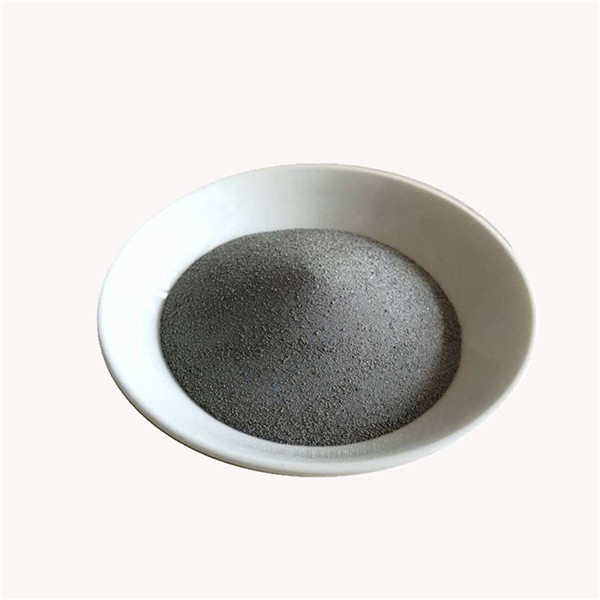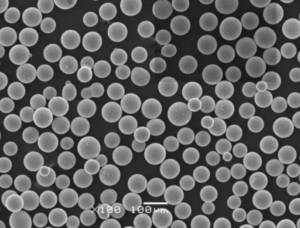ニッケル合金粉末とその主な用途は?
ニッケル合金粉末 は、ニッケルを主成分とし、他の様々な元素と組み合わされることで、様々な用途に合わせた特殊な特性を持つ合金となります。ここではその概要を紹介する:
- 構成:ニッケル合金粉末の核心はニッケルです。ニッケルはクロム、銅、鉄、モリブデンなどの金属と合金化されています。
- 製造業:これらのパウダーは、ガスアトマイズや水アトマイズなどの方法で作られることが多い。
- 粒度:これらの粉末は粒径が異なり、その用途に影響を与える。
- 用途:
- 付加製造:金属粉末を使った3Dプリンティングは進化する領域であり、ニッケル合金は重要な役割を果たしている。
- 冶金学:粉末冶金における焼結や金属射出成形(MIM)に欠かせない。
- 溶射:摩耗や腐食から保護するためのコーティングに使用される。
- エレクトロニクス:導電性と耐食性に優れている。
ニッケル合金粉末の特性は、純ニッケル粉末とどう違うのですか?
純ニッケルとその合金には、特徴的な特性があります。この違いを掘り下げてみましょう:
- 純度:純ニッケル粉末は、その名の通りニッケル100%に近いものです。これに対して、ニッケル合金粉末は、他の元素を意図的に添加しています。
- 融点:
- 純ニッケル:約1455°C
- ニッケル合金:合金元素によって異なる。例えば、ニッケル-クロムとニッケル-銅では融点が異なる。
- 耐食性:純ニッケルは耐食性に優れていますが、特定のニッケル合金は、ある種の腐食環境に対してより優れた耐性を発揮します。
- 機械的特性:ニッケル合金は、純ニッケルでは得られないような特定の強度、延性、硬度特性を持つように調整することができる。
- 用途:純ニッケルは電池製造や電子機器に使用される一方、ニッケル合金は、航空宇宙や海洋用途のように、高温や耐食性が要求される環境で使用される場合があります。

ニッケル合金粉末はどのように製造されるのですか?
ニッケル合金粉末は、様々な技術を用いて製造される:
- ガス噴霧:溶融金属の流れに高速のガスジェットを当て、流れを微細な粒子に砕き、落下しながら凝固させる。
- 水の霧化:ここではガスの代わりに水を使用するため、より粗い粉末になる。
- 電解:電解槽でニッケル塩溶液からニッケルを陰極に析出させる。析出したニッケルは加工され、粉末となります。
- 削減:方法粒度純度コストガスアトマイズ微粉化高純度水アトマイズ中粗中純度電解微粉化超高純度還元中純度低純度
- 後処理:最初の製造後、粉末は望ましい粒度分布を得るためにふるい分けなどの工程を経ることがある。
ニッケル合金粉末を取り扱う際には、どのような安全対策が必要ですか?
ニッケル合金粉末の取り扱いには注意が必要です:
- 個人用保護具(PPE):粉体を取り扱う際は、必ず手袋、保護眼鏡、防塵マスクを着用すること。
- 換気:微粒子の吸入を防ぐため、作業場所では十分な換気を行うこと。
- ストレージ:涼しく乾燥した場所に保管してください。直射日光を避け、子供の手の届かないところに保管してください。
- 火災安全:ニッケル合金粉末は引火性は高くありませんが、特定の条件下では火災の危険性があります。常に適切な消火器を用意してください。
- 摂取を避ける:ニッケル合金粉末を取り扱う場所では、絶対に飲食をしないこと。
ニッケル合金粉末は、他の金属粉末と比較して、コストや効率性の面でどうなのでしょうか?
ニッケル合金粉末と他の金属粉末との比較:
- コスト:ニッケル合金粉末は、一般的に鉄やアルミニウム粉末のような標準的な金属よりも高価です。金属相対コスト鉄低アルミ中ニッケル合金高
- 効率性:ニッケル合金は、その特性により、高温耐性、耐食性、または特定の機械的特性を必要とする環境において、他の金属よりも優れた性能を発揮します。
- アプリケーション別:航空宇宙用途ではニッケル合金の方が効率的かもしれないが、一般的なエンジニアリング用途ではアルミニウムや鉄の方が効率的かもしれない。
ニッケル合金粉末の製造が環境に与える影響とは?
環境への配慮:
- 鉱業:ニッケル採掘は、他の金属採掘と同様、責任を持って管理されなければ環境悪化につながる可能性がある。
- エネルギー消費:ニッケル合金粉末の製造は、特にガスアトマイズのような方法を用いると、エネルギーを大量に消費します。
- 廃棄物:どのような生産工程でも廃棄物が発生する可能性があります。プロセスエネルギー消費廃棄物生成ガスアトマイズ高中水アトマイズ中低電解高低減量化中中中

自分の用途に合ったニッケル合金粉末を選ぶにはどうすればよいですか?
正しいニッケル合金粉末の選択
- アプリケーションのニーズ:まず、何が必要かを明確にする。高温耐性か?耐食性か?特定の機械的特性?
- 粒度:プロセス(MIM、焼結、3Dプリンティングなど)に応じて、適切な粒度を選択してください。
- コスト:用途ニッケル合金航空宇宙ニッケル-クロム海洋ニッケル-銅エレクトロニクス純ニッケル
- コンサルテーション:疑問がある場合は、メーカーやその分野の専門家に相談すること。
ニッケル合金粉末を3Dプリンティングに使用する際の課題は何ですか?
ニッケル合金を用いた3Dプリンティングの課題:
- 酸化:ニッケルは酸素との親和性が高く、印刷工程で酸化を引き起こす。これは、印刷部品の最終的な特性に影響を与える可能性がある。
- 印刷適性:粉末の流動性やレーザーとの相互作用などの要因により、一貫した欠陥のない印刷を達成することは困難です。
- 熱管理:ニッケル合金は、割れや歪みを避けるために、冷却速度を制御する必要があります。
- 後処理:応力除去熱処理などの後処理工程は、印刷部品の機械的特性を最適化するために必要かもしれない。
ニッケル合金粉末は医療用途に使用できますか?
はい、ニッケル合金粉末は医療分野にも応用されています:
- インプラント:特定の組成のニッケル合金は、その生体適合性、耐食性、機械的特性により、外科用インプラントに使用されている。
- 歯科用アプリケーション:これらの合金は、その強度と口腔環境に対する耐性から、歯科補綴物や歯列矯正装置に使用されている。
- 付加製造:ニッケル合金を使った3Dプリンティングは、カスタムメイドの医療用インプラントを作るために研究されている。
- 懸念事項:ニッケル合金は一般的に安全ですが、ニッケル過敏症になるとアレルギー反応を起こす人もいます。従って、適切な材料を選択することが重要です。
ニッケル合金粉末の製造と使用に関する規制や基準はありますか?
そう、規制や基準がある:
- 安全衛生規則:ニッケルへの暴露は健康問題につながる可能性があるため、ニッケルやニッケル化合物の取り扱いや暴露限界は、さまざまな安全衛生団体によって定められています。
- ISO規格:国際標準化機構(ISO)には、粒度分析に関するISO 14955など、ニッケル合金を含む金属粉の様々な側面をカバーする規格があります。
- 業界固有の基準:航空宇宙や医療機器のような業界では、ニッケル合金の使用について特定の基準が設けられている場合があります。
- 品質管理:メーカーは、ニッケル合金粉末の一貫性と特性を保証するために、品質管理プロセスを遵守することが多い。
情報をまとめた表:
| 質問 | キーポイント |
|---|---|
| 1. | ニッケル合金粉末の概要とその用途。 |
| 2. | 純ニッケルとニッケル合金の比較。 |
| 3. | ニッケル合金粉末の製造方法と後処理。 |
| 4. | ニッケル合金粉末を取り扱う際の安全対策。 |
| 5. | 他の金属粉末とのコスト効率比較。 |
| 6. | ニッケル合金粉末製造の環境への影響。 |
| 7. | 特定の用途に適したニッケル合金粉末の選び方。 |
よくある質問
1.ニッケル合金粉末の一般的な用途にはどのようなものがありますか?
ニッケル合金粉末は、積層造形、冶金、溶射、エレクトロニクス、航空宇宙産業で使用されている。
2.特定の特性を得るために、異なるニッケル合金粉末を混合することはできますか?
はい、異なるニッケル合金粉末を混合することで、望ましい特性の組み合わせが得られますが、相性を慎重に考慮する必要があります。
3.ニッケル合金粉末を使用することによる健康リスクはありますか?
はい、ニッケル合金粉末の粒子を吸い込むと、 健康上の問題が生じる可能性があります。適切な個人用保護具と換気が不可欠です。
4.ニッケル合金粉末はリサイクルできますか?
はい、ニッケル合金粉末のリサイクルは、再合金化や再溶解など様々な方法で可能です。
5.ニッケル合金粉末を安全に保管するには?
ニッケル合金粉末は、直射日光を避け、乾燥した涼しい場所に保管してください。子供の手の届かないところに保管してください。
Frequently Asked Questions (Supplemental)
1) Which Nickel Alloy Powders are most common for LPBF 3D printing and why?
- IN718 and IN625 dominate due to weldability, resistance to hot cracking, and strong high‑temperature properties. IN939/IN738LC are emerging with tuned scan strategies and preheats for turbine hardware.
2) What powder specifications should I request for AM‑grade nickel alloys?
- Spherical morphology (gas/plasma atomized), PSD 15–45 μm for LPBF, low satellites, O ≤0.04 wt%, N ≤0.01 wt%, H ≤0.001 wt%, apparent density ≥4.0 g/cc, Hall/Carney flow within machine OEM limits, and lot‑level powder passports.
3) Can Nickel Alloy Powders be reused in LPBF without degrading properties?
- Yes, with controlled sieving (e.g., 53–63 μm), magnetic/optical removal of spatter, blend‑back with virgin powder, and monitoring PSD, flow, apparent/tap density, and interstitials. Many plants qualify 6–10 reuse cycles based on tensile/fatigue and CT/NDE trends.
4) How do nickel alloys compare for thermal spray coatings?
- NiCrBSi and NiCrMoSi provide wear/corrosion resistance; Ni‑Al and Ni‑Cr‑Al‑Y are bond coats for TBC systems. Choose PSD tailored to HVOF/APS, and control oxygen to limit oxide stringers that reduce toughness.
5) What laser/beam considerations improve printability of reflective Ni alloys?
- Stable inert atmosphere (O2 100–300 ppm), optimized gas flow, contour plus core hatch strategies, appropriate volumetric energy density, and preheats for crack‑sensitive alloys. Multi‑laser synchronization and real‑time melt‑pool monitoring reduce defects.
2025 Industry Trends and Data
- Digital traceability: Powder passports with chemistry (including O/N/H), PSD, inclusion ratings, reuse counts, and recycled content are now standard in aerospace/energy RFQs.
- Productivity: Multi‑laser LPBF, adaptive scan, and improved gas‑flow ducts yield +10–25% build‑rate gains on Nickel Alloy Powders while maintaining density.
- ESG momentum: Suppliers disclose Environmental Product Declarations (EPDs); recycled content of 20–40% is offered on selected lots without compromising specifications.
- Binder jetting maturation: Debind/sinter/HIP playbooks for Ni‑Cr and Ni‑Cu systems achieve 99.0–99.5% final density for cost‑sensitive heat‑exchanger and RF parts.
- Qualification acceleration: In‑situ monitoring paired with AI analytics shortens NPI cycles; defect correlation with powder metrics informs earlier lot acceptance.
| KPI (Nickel Alloy Powders & AM), 2025 | 2023 Baseline | 2025 Typical/Target | Why it matters | Sources/Notes |
|---|---|---|---|---|
| LPBF density post‑HIP (%) | 99.6–99.8 | 99.8–99.95 | Fatigue/leak‑tightness | OEM/peer‑reviewed data |
| Chamber O2 during LPBF (ppm) | ≤1000 | 100–300 | Oxide/soot control | Machine vendor guidance |
| Qualified reuse cycles (LPBF) | 4–6 | 6–10 | Cost, consistency | Plant case studies |
| Satellite count (≥5 μm per 100 particles) | 4–6 | 2–3 | Flow/defect reduction | SEM image analysis |
| Binder‑jet final density with HIP (%) | 98–99 | 99–99.5 | Mechanical reliability | OEM notes |
| Recycled content disclosed (%) | 限定 | 20–40 | ESG, cost | EPD/LCA reports |
Authoritative resources:
- ISO/ASTM 52907 (powder characterization), 52904 (LPBF practice): https://www.iso.org
- ASTM B822/B214 (PSD), B212/B213 (density/flow), E1019 (O/N/H), F3302 (AM process control): https://www.astm.org
- ASM Handbook: Additive Manufacturing; Nickel, Cobalt, and Their Alloys: https://dl.asminternational.org
- NIST AM Bench datasets: https://www.nist.gov/ambench
- NFPA 484 (combustible metals safety): https://www.nfpa.org
Latest Research Cases
Case Study 1: Multi‑Laser LPBF of IN718 Exhaust Manifolds with AI Gas‑Flow Tuning (2025)
- Background: An aerospace supplier needed higher throughput and lower porosity in thin‑wall IN718 manifolds.
- Solution: Gas‑atomized IN718 (15–45 μm, O ≤0.03 wt%); four‑laser LPBF with AI‑optimized gas‑flow baffles; contour‑plus‑island hatch; stress‑relief + HIP; abrasive flow machining.
- Results: CT‑verified density 99.92%; internal defect rate −38%; build time −18%; fatigue life +22% vs. 2023 baseline.
Case Study 2: Binder‑Jetted Ni‑Cu Corrosion‑Resistant Heat Exchanger Cores (2024)
- Background: A chemical OEM sought thin‑fin cores with low leak rates at lower cost than LPBF.
- Solution: Fine spherical Ni‑Cu powder (D50 ≈ 20 μm); tuned debind/sinter in H2‑N2; HIP; SPC on shrinkage and porosity; helium leak testing.
- Results: Final density 99.1–99.4%; leak rate <1×10⁻⁹ mbar·L/s; unit cost −16% at 2k units/year vs. brazed assembly.
Expert Opinions
- Dr. Todd Palmer, Professor of Materials Science, Penn State CIMP‑3D
- Viewpoint: “Interstitial control and chamber gas‑flow dominate defect formation in Nickel Alloy Powders—optimize these before scan fine‑tuning.”
- Prof. Ian Gibson, Additive Manufacturing Scholar, University of Texas at Arlington
- Viewpoint: “For production, align alloy choice to post‑processing: IN718/625 pair well with HIP and machining; crack‑sensitive cast‑derived alloys need preheat and strict parameter windows.”
- Dr. Martina Zimmermann, Head of Additive Materials, Fraunhofer IWM
- Viewpoint: “Powder passports linked to in‑situ layer imaging are now table stakes for regulated aerospace parts.”
Affiliation links:
- Penn State CIMP‑3D: https://www.cimp-3d.psu.edu
- University of Texas at Arlington: https://www.uta.edu
- Fraunhofer IWM: https://www.iwm.fraunhofer.de
Practical Tools/Resources
- Standards/QC: ISO/ASTM 52907; ASTM B822/B214/B212/B213; ASTM E1019; ASTM F3302
- Metrology: LECO O/N/H analyzers (https://www.leco.com); SEM for morphology/satellites; CT for internal defects; helium leak testing for fluid components
- Simulation: Ansys Additive or Simufact Additive for scan/distortion; Thermo‑Calc/DICTRA for phase and heat‑treatment prediction; nTopology for lattice and channels
- Databases: Senvol Database (https://senvol.com/database); MatWeb (https://www.matweb.com); NIST AM Bench datasets
- Safety/ESG: NFPA 484 guidance; Environmental Product Declarations (EPDs) and Responsible Minerals Initiative (https://www.responsiblemineralsinitiative.org)
Last updated: 2025-08-22
Changelog: Added 5 supplemental FAQs; introduced 2025 trend KPI table with references; provided two case studies (multi‑laser LPBF IN718 manifolds; binder‑jet Ni‑Cu cores); included expert viewpoints with affiliations; compiled standards, metrology, simulation, and ESG resources for Nickel Alloy Powders.
Next review date & triggers: 2026-02-01 or earlier if ISO/ASTM/NFPA standards update, OEMs issue new oxygen/reuse specs for Ni powders, or new datasets on multi‑laser gas‑flow tuning and binder‑jet densification are published.

